

The practice of beekeeping is one of those pursuits that can be as complicated as you’d like to make it. Just as soon as you have an understanding of the waggle dance or become practiced with techniques such as swarm control, it seems there’s always something more to learn and another chapter in the proverbial beekeeping encyclopedia to read. Perhaps that’s one reason why beekeeping can be such an addictive pursuit.
But while beekeeping can be as endlessly complex as you’d like to make it, honey bees themselves can, for the most part, handle quite a bit themselves.
At a baseline level, bees need a suitable cavity in which to live with protection from the elements and predators, food, help with pests and diseases as needed, and also, critically – water.
In this article, we’ll detail the why, when, where, and how of how to provide water for your bees – whether you’re just starting out beekeeping or maybe you just love watching honey bees in your yard and would like to help them out on hot days.
The practice of beekeeping is one of those pursuits that can be as complicated as you’d like to make it. Just as soon as you have an understanding of the waggle dance or become practiced with techniques such as swarm control, it seems there’s always something more to learn and another chapter in the proverbial beekeeping encyclopedia to read. Perhaps that’s one reason why beekeeping can be such an addictive pursuit.
But while beekeeping can be as endlessly complex as you’d like to make it, honey bees themselves can, for the most part, handle quite a bit themselves.
At a baseline level, bees need a suitable cavity in which to live with protection from the elements and predators, food, help with pests and diseases as needed, and also, critically – water.
In this article, we’ll detail the why, when, where, and how of how to provide water for your bees – whether you’re just starting out beekeeping or maybe you just love watching honey bees in your yard and would like to help them out on hot days.
Why Honey Bees Need Water
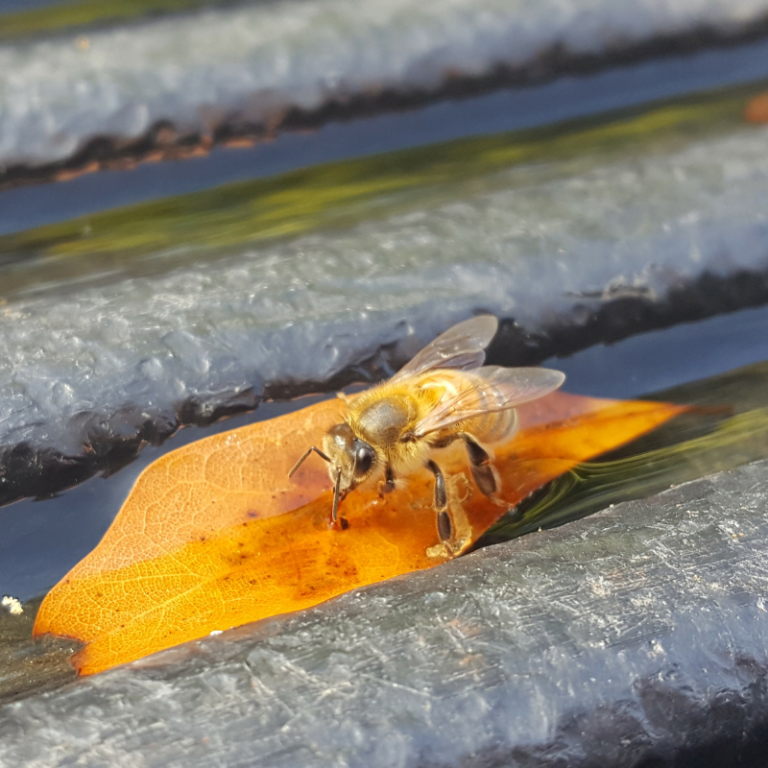
Bees collect water throughout the year to drink, to obtain additional nutrients, to process honey, and to cool the hive through evaporative cooling during summer heat waves. Just like when working a particular nectar flow, honey bees are both stubborn and picky when it comes to a water source.
Once they are on a water source, they are typically dedicated to it – whether it’s a nearby creek or your neighbor’s swimming pool – even if the beekeeper provides a more seemingly suitable source closer to the apiary later.
Why Honey Bees Need Water

Bees collect water throughout the year to drink, to obtain additional nutrients, to process honey, and to cool the hive through evaporative cooling during summer heat waves. Just like when working a particular nectar flow, honey bees are both stubborn and picky when it comes to a water source.
Once they are on a water source, they are typically dedicated to it – whether it’s a nearby creek or your neighbor’s swimming pool – even if the beekeeper provides a more seemingly suitable source closer to the apiary later.
What Bees Are Looking For In A Water Source
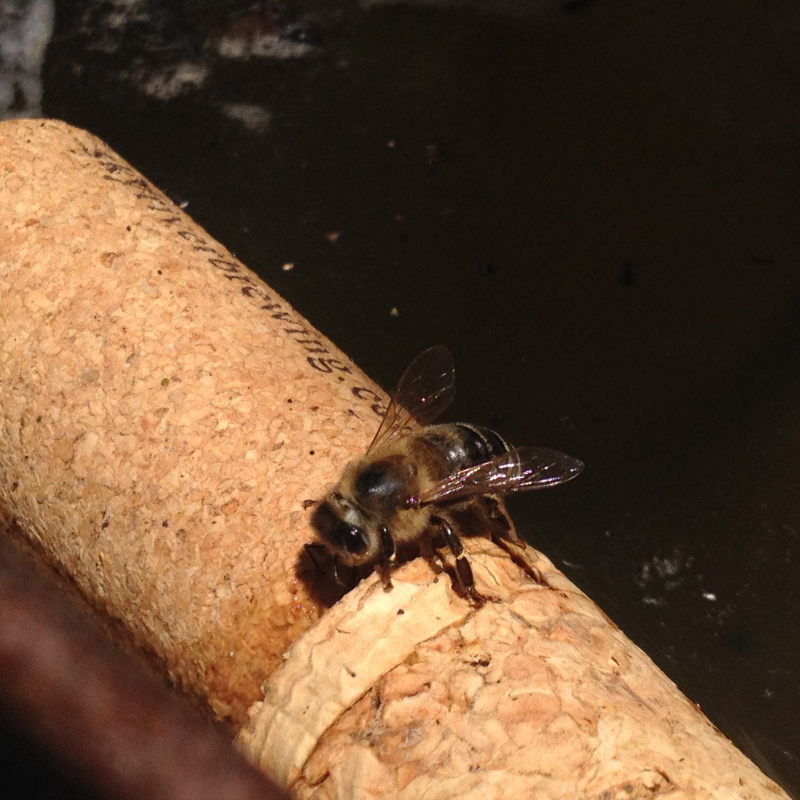
If you have a natural water source nearby that your bees can easily access year-round, you might be in luck without any further action needed on your part.
However, many of us don’t have this luxury and even if we do, providing water closer to your apiary will just make everything more efficient for your bees. Bees look for a few things when it comes to water – ease of access (bees are extremely poor swimmers), dependability (water will always be available), temperature, and given the choice – nutrients and scent.
Temperature is critical. In fact, if your bees are continually ignoring a closer source and are opting to fly to a neighbor’s livestock tanks or swimming pool instead, it could be as simple as moving the water source out of the shade.
If the water is too cold, it becomes difficult for the bees to load up on water without chilling their bodies so much that flying becomes difficult – sun is always preferred to shade when it comes to bees and your bees drinking water.
What Bees Are Looking For In A Water Source

If you have a natural water source nearby that your bees can easily access year-round, you might be in luck without any further action needed on your part.
However, many of us don’t have this luxury and even if we do, providing water closer to your apiary will just make everything more efficient for your bees. Bees look for a few things when it comes to water – ease of access (bees are extremely poor swimmers), dependability (water will always be available), temperature, and given the choice – nutrients and scent.
Temperature is critical. In fact, if your bees are continually ignoring a closer source and are opting to fly to a neighbor’s livestock tanks or swimming pool instead, it could be as simple as moving the water source out of the shade.
If the water is too cold, it becomes difficult for the bees to load up on water without chilling their bodies so much that flying becomes difficult – sun is always preferred to shade when it comes to bees and your bees drinking water.
Clean Water Not Required
Clean Water Not Required
If you ask the old-timers about water for bees, they might suggest adding just a bit of bleach to your bee’s water to get them interested (bees love the scent of bleach, frequently causing conflict with hot tubs or swimming pools), however beekeepers preferring a chemical-free approach can help by simply not cleaning your water source too often.
A little dirt and algae will be of no concern to the bees – in fact they prefer it. The scent allows them to find the water source more easily, and the fact of the matter is that dirty water will provide additional nutrients that your bees want. Others may suggest a pinch of salt, or supplements and essential oils, if you’re so inclined. This is not typically required however, as long as the rest of their needs for water are met.
If you ask the old-timers about water for bees, they might suggest adding just a bit of bleach to your bee’s water to get them interested (bees love the scent of bleach, frequently causing conflict with hot tubs or swimming pools), however beekeepers preferring a chemical-free approach can help by simply not cleaning your water source too often.
A little dirt and algae will be of no concern to the bees – in fact they prefer it. The scent allows them to find the water source more easily, and the fact of the matter is that dirty water will provide additional nutrients that your bees want. Others may suggest a pinch of salt, or supplements and essential oils, if you’re so inclined. This is not typically required however, as long as the rest of their needs for water are met.
Different Ways To Provide Water For Bees
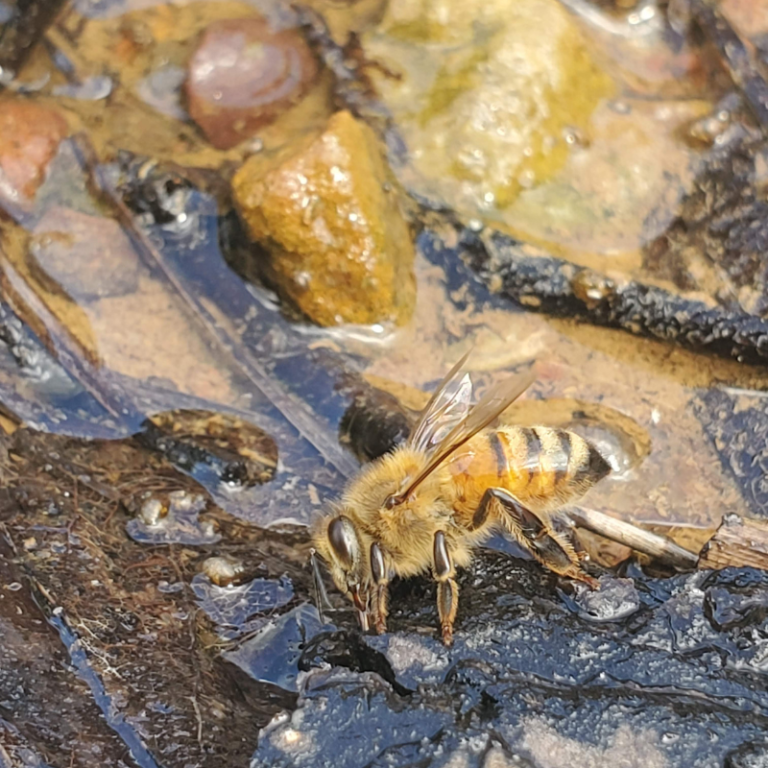
Providing water can be done in many ways. You do not need to locate your water source immediately adjacent to your hives – lore has it that bees often ignore everything from nectar sources to water that is immediately within the apiary.
As with most things you hear in beekeeping, this is sometimes true. Regardless, the water source should be located in a place convenient for the beekeeper to refill and maintain (close to a water faucet or vehicle access for example), and be large enough that you’re not having to refill it too often.
Water usage and evaporation rate will vary, but half a gallon to a gallon per day per hive is a good general estimate during the heat of summer.
Keep in mind that you’ll have losses from any other hives in the area that find your water source, opportunistic wildlife, and so on.
Different Ways To Provide Water For Bees

Providing water can be done in many ways. You do not need to locate your water source immediately adjacent to your hives – lore has it that bees often ignore everything from nectar sources to water that is immediately within the apiary.
As with most things you hear in beekeeping, this is sometimes true. Regardless, the water source should be located in a place convenient for the beekeeper to refill and maintain (close to a water faucet or vehicle access for example), and be large enough that you’re not having to refill it too often.
Water usage and evaporation rate will vary, but half a gallon to a gallon per day per hive is a good general estimate during the heat of summer.
Keep in mind that you’ll have losses from any other hives in the area that find your water source, opportunistic wildlife, and so on.
Containers For Water
Containers For Water
You can provide water with nearly any type of basin. Some examples include a bird bath, livestock tanks (available in a very wide range of sizes), food service tubs, buckets, and automatic livestock waterers – chicken waterers are commonly used by many beekeepers. Boardman feeders, or variations of that basic design, can also be utilized.
Automatic waterers are convenient in that they protect the majority of the water source from evaporation while keeping the water level more or less constant for the bees, and can be purchased or made at home. Regardless of what you choose, you must provide an easy way for your bees to access the water, minimize the risk of drowning, and have ways for them to escape if they were to be blown or fall into the water source.
If using a shallower basin such as a livestock waterer or a more shallow tub, rocks that are around half submerged and half above the surface of the water are ideal. The more rocks the better, as your bees will utilize the rocks to land on and drink from, and to escape the water when they do fall in. If your basin is deeper as with many livestock tanks, floats can be another option.
Again, the more the better. With this method, everything from corks to sticks or wood chips can be utilized and as the water level changes, the floats are always right on the surface of that varying water level. Just make sure to utilize non-toxic and preferably food-grade materials if possible.
You can provide water with nearly any type of basin. Some examples include a bird bath, livestock tanks (available in a very wide range of sizes), food service tubs, buckets, and automatic livestock waterers – chicken waterers are commonly used by many beekeepers. Boardman feeders, or variations of that basic design, can also be utilized.
Automatic waterers are convenient in that they protect the majority of the water source from evaporation while keeping the water level more or less constant for the bees, and can be purchased or made at home. Regardless of what you choose, you must provide an easy way for your bees to access the water, minimize the risk of drowning, and have ways for them to escape if they were to be blown or fall into the water source.
If using a shallower basin such as a livestock waterer or a more shallow tub, rocks that are around half submerged and half above the surface of the water are ideal. The more rocks the better, as your bees will utilize the rocks to land on and drink from, and to escape the water when they do fall in. If your basin is deeper as with many livestock tanks, floats can be another option.
Again, the more the better. With this method, everything from corks to sticks or wood chips can be utilized and as the water level changes, the floats are always right on the surface of that varying water level. Just make sure to utilize non-toxic and preferably food-grade materials if possible.
Water Throughout The Seasons
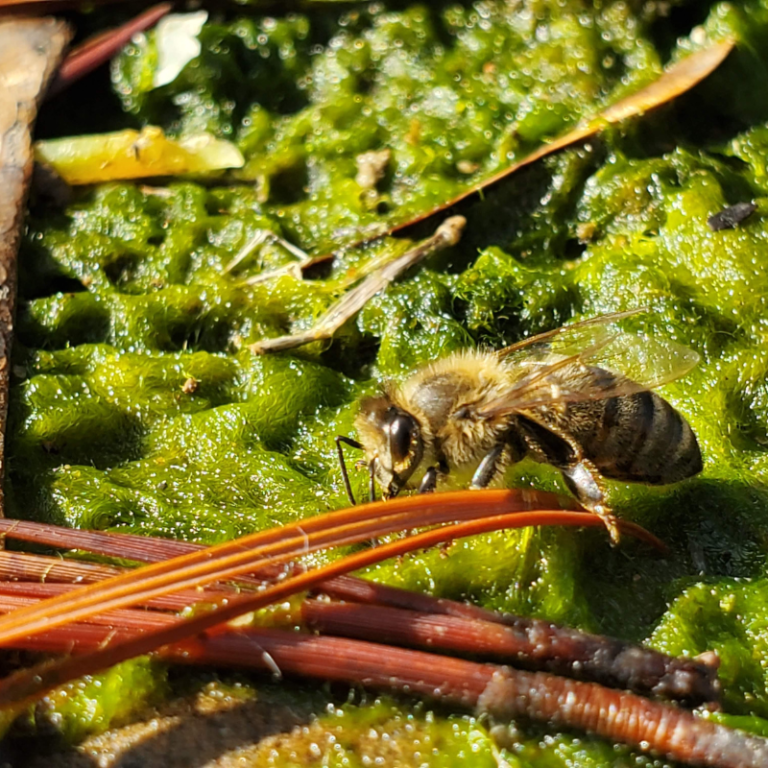
Bees drink water throughout the seasons and honey bee colonies should be provided with water year-round. In the summer your bees will need this water to keep the hive at a constant temperature, and in the winter they’ll need water to rehydrate food stores that may have crystalized in combs, and to drink.
However, in cold climates you likely will not need to heat your water source to keep it from freezing. In fact, allowing it to freeze into a solid block (make sure the ice has room to expand in such a manner that your container will not be broken) is typically just fine.
In freezing conditions your bees will be clustered and not flying, relying on condensation within the hive as a water source if needed. When temperatures warm, melting snow in front of the hives or on the landing board is typically used by the colony.
Once the weather warms enough for good flying weather, the water source you’ve provided should melt and the bees will resume using it as needed.
Water Throughout The Seasons

Bees drink water throughout the seasons and honey bee colonies should be provided with water year-round. In the summer your bees will need this water to keep the hive at a constant temperature, and in the winter they’ll need water to rehydrate food stores that may have crystalized in combs, and to drink.
However, in cold climates you likely will not need to heat your water source to keep it from freezing. In fact, allowing it to freeze into a solid block (make sure the ice has room to expand in such a manner that your container will not be broken) is typically just fine.
In freezing conditions your bees will be clustered and not flying, relying on condensation within the hive as a water source if needed. When temperatures warm, melting snow in front of the hives or on the landing board is typically used by the colony.
Once the weather warms enough for good flying weather, the water source you’ve provided should melt and the bees will resume using it as needed.
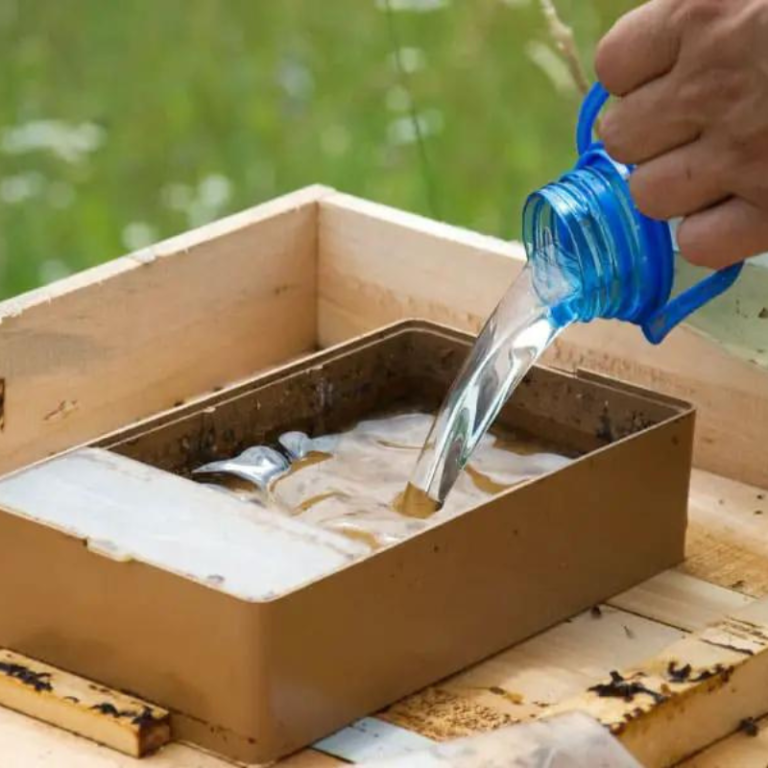
Once your bees get used to using a water source you’ve provided, make sure to keep your bee waterer full or your bees may fly elsewhere, and it can be difficult to convince them to change sources once they’re on one.
A watering station also provides a great way to watch your bees and your honey bees drink water – they typically are not defensive of their water source like they might be around their hive.
While standard disclaimers apply, it can be an interesting experience to refill the bee watering station suitless and smokeless while being surrounded by hundreds or thousands of thirsty worker bees. Thus, providing water for a honey bee colony or apiary may just provide some entertainment value for the beekeeper as well.
Whether it’s natural or man-made, a water source should be within easy flying distance, dependable and easy for the beekeeper to maintain, and safe for the bees to utilize. Granted, as resourceful as honey bees are, they’re likely to find a water source whether you provide one or not.
However, ensuring an appropriate water source for your apiary is something that should be on every beekeeper’s agenda and will help to keep your hives healthy and keep your apiary operating at maximum efficiency.

Once your bees get used to using a water source you’ve provided, make sure to keep your bee waterer full or your bees may fly elsewhere, and it can be difficult to convince them to change sources once they’re on one.
A watering station also provides a great way to watch your bees and your honey bees drink water – they typically are not defensive of their water source like they might be around their hive.
While standard disclaimers apply, it can be an interesting experience to refill the bee watering station suitless and smokeless while being surrounded by hundreds or thousands of thirsty worker bees. Thus, providing water for a honey bee colony or apiary may just provide some entertainment value for the beekeeper as well.
Whether it’s natural or man-made, a water source should be within easy flying distance, dependable and easy for the beekeeper to maintain, and safe for the bees to utilize. Granted, as resourceful as honey bees are, they’re likely to find a water source whether you provide one or not.
However, ensuring an appropriate water source for your apiary is something that should be on every beekeeper’s agenda and will help to keep your hives healthy and keep your apiary operating at maximum efficiency.

